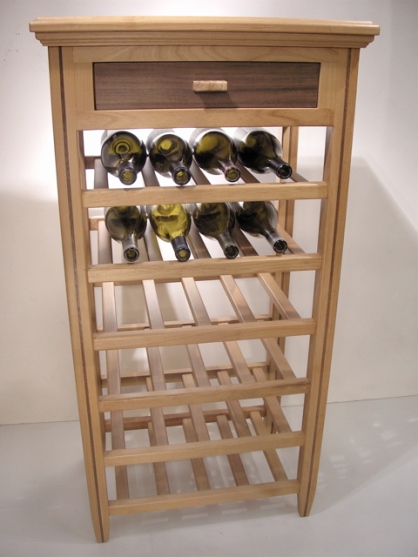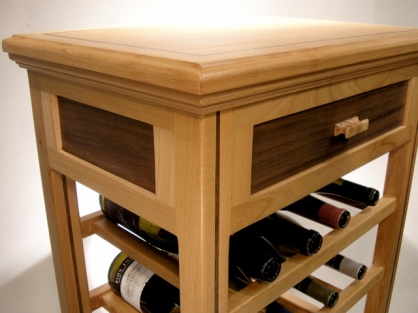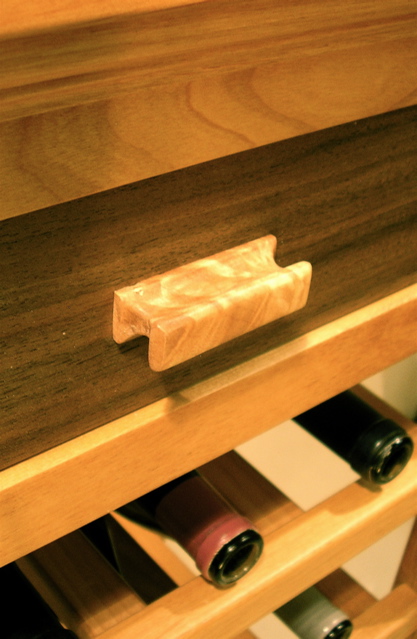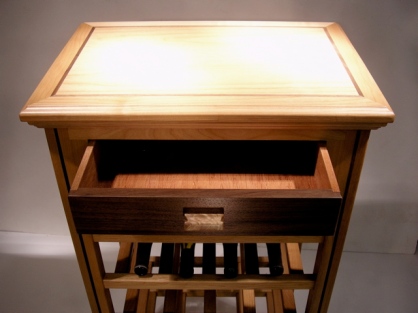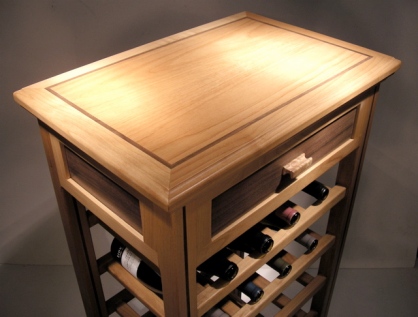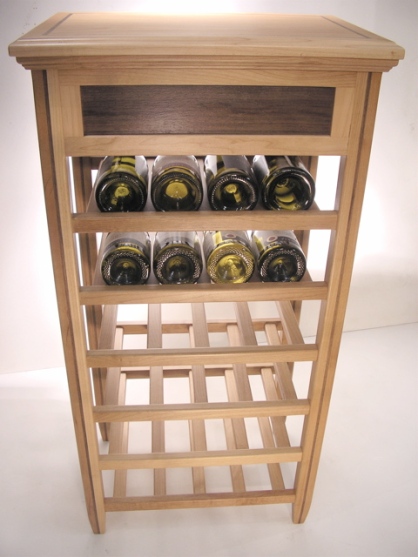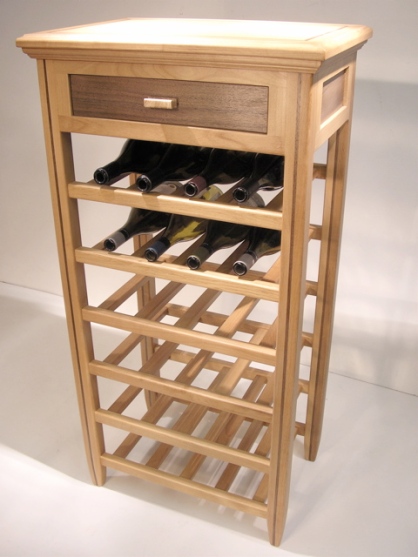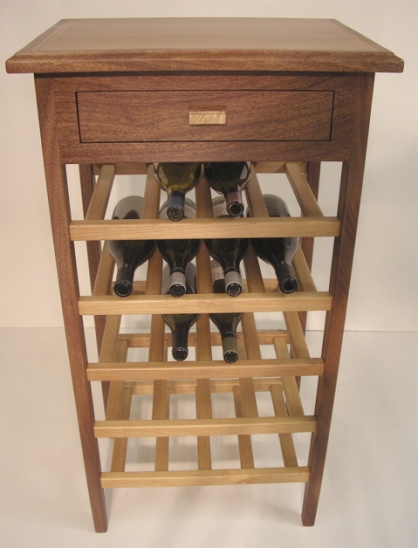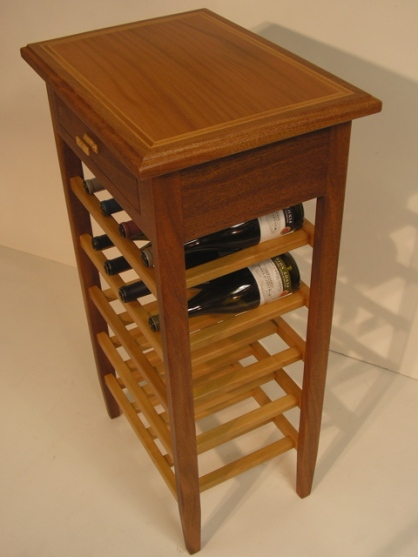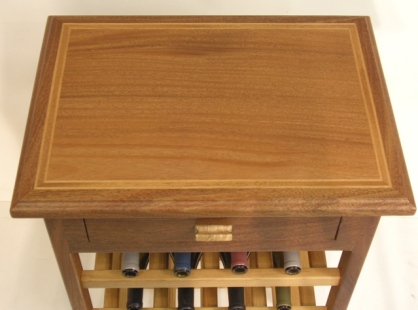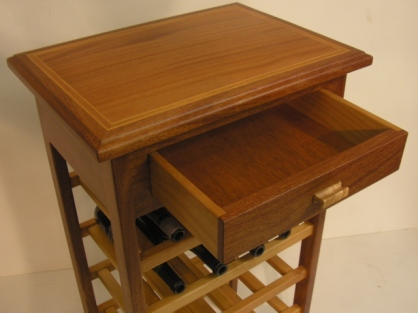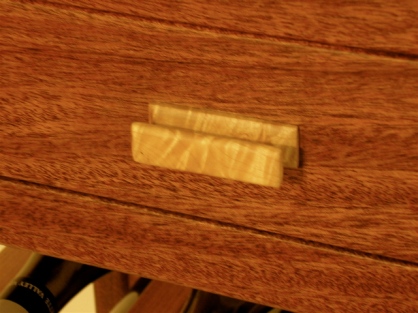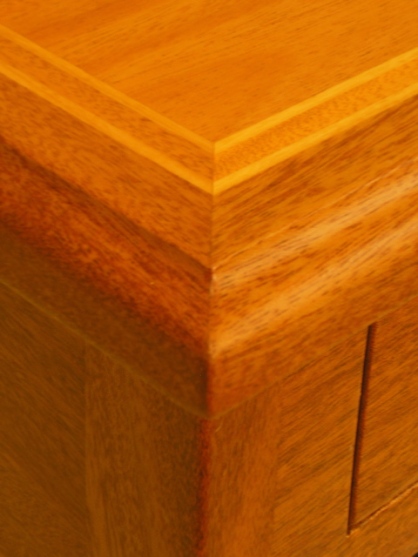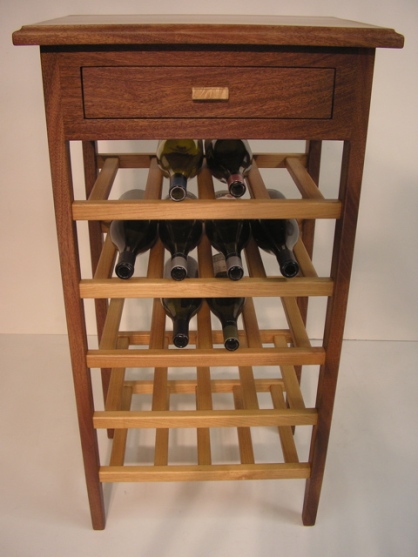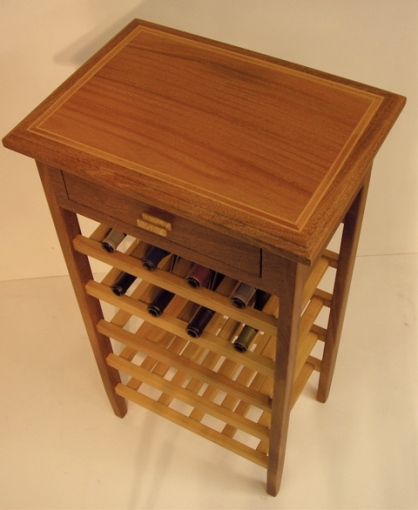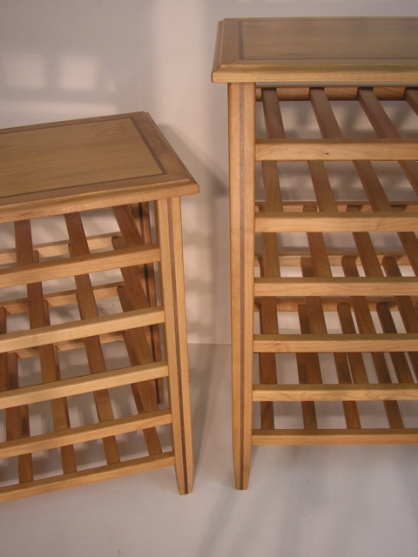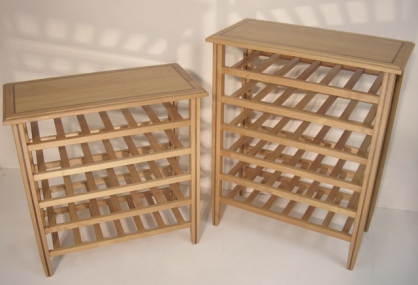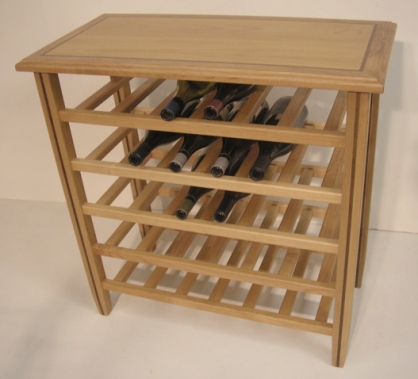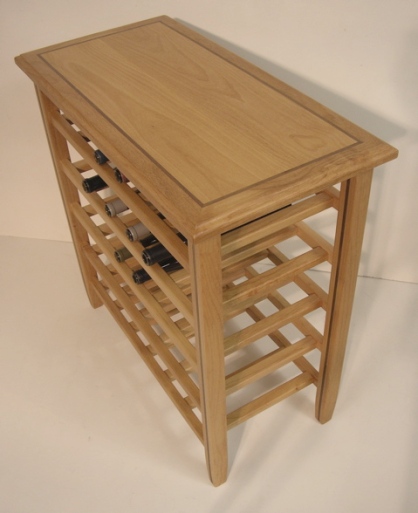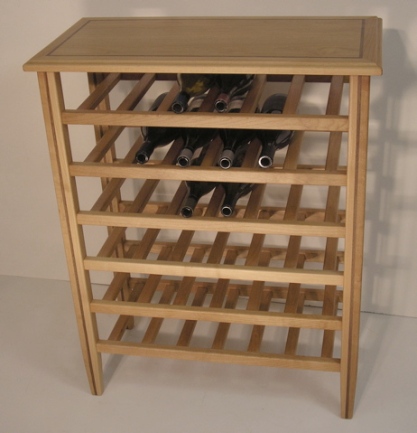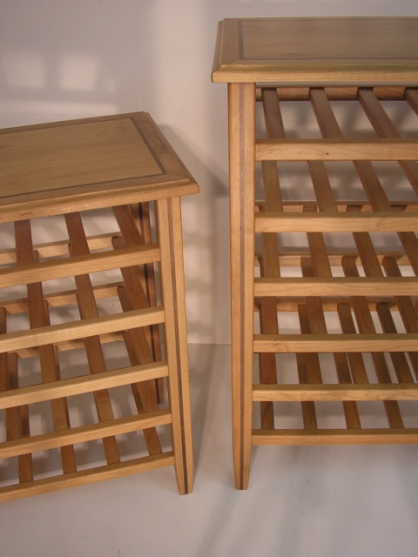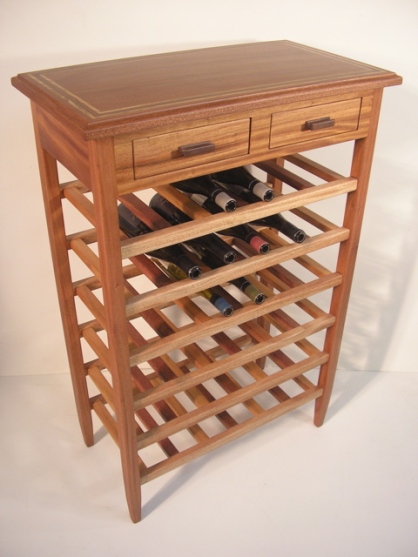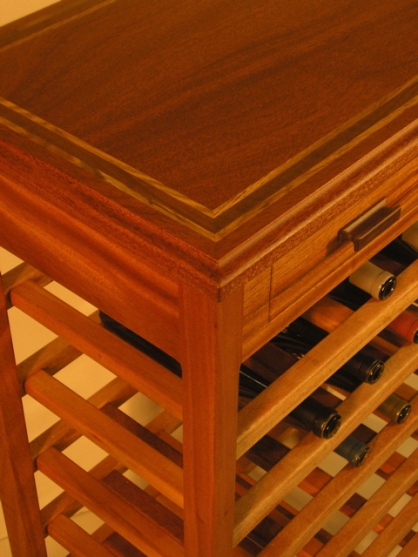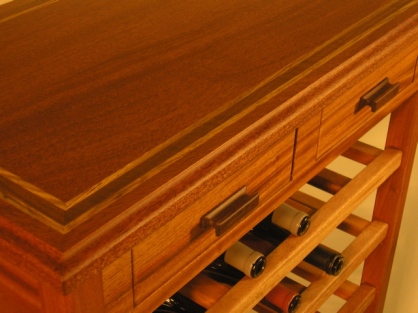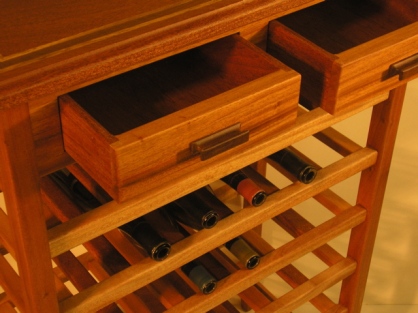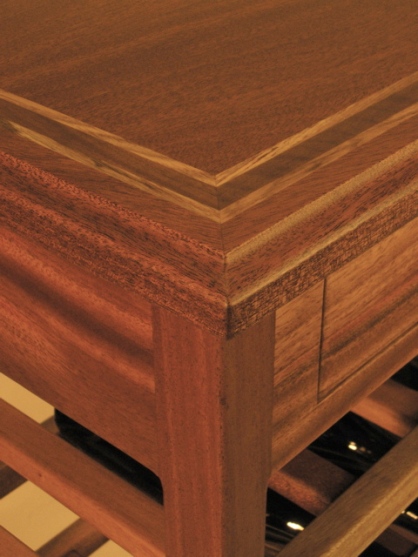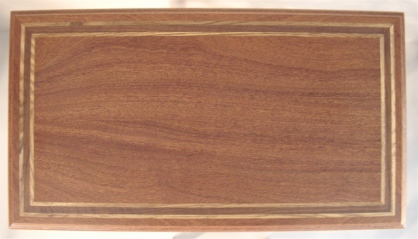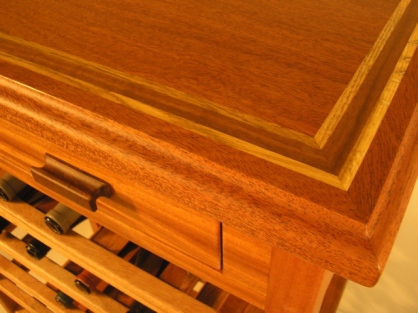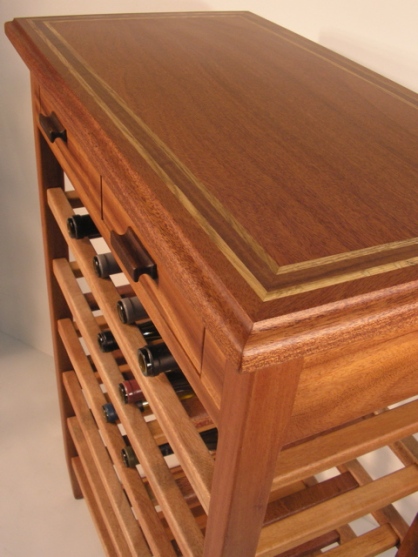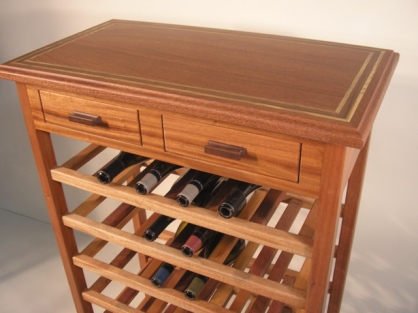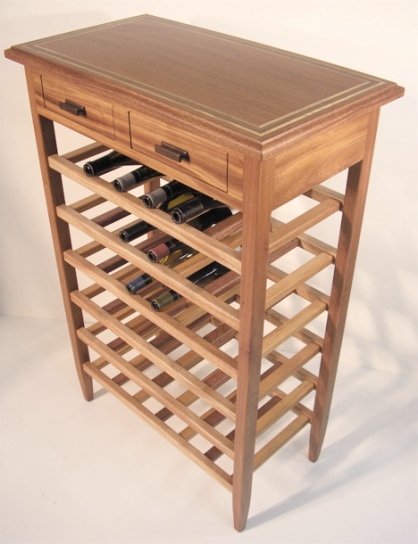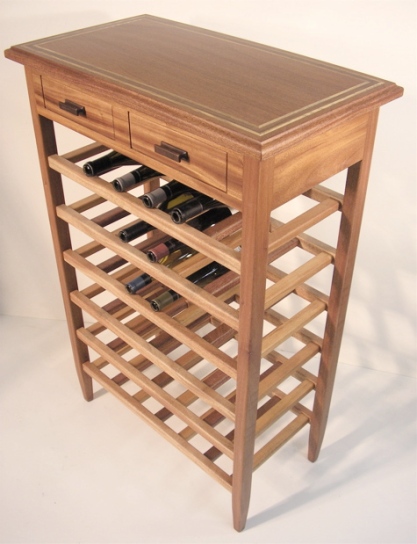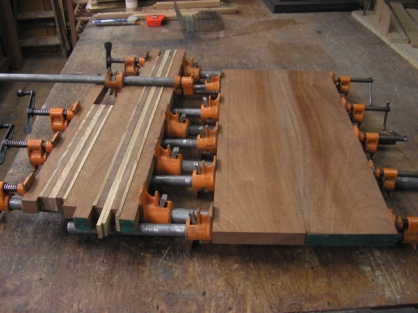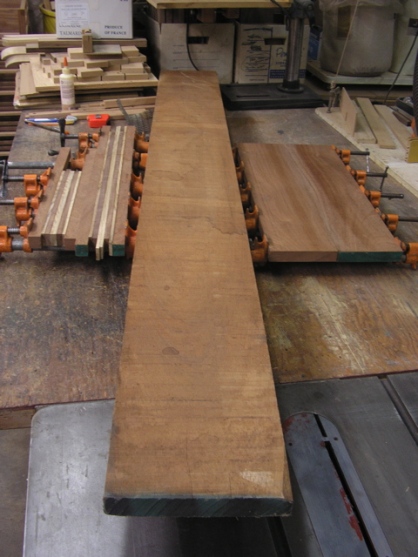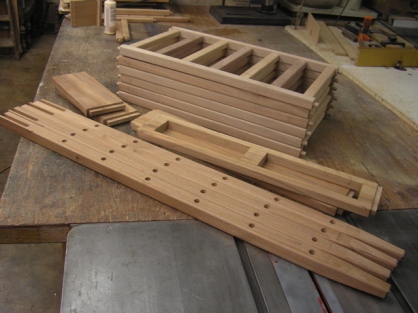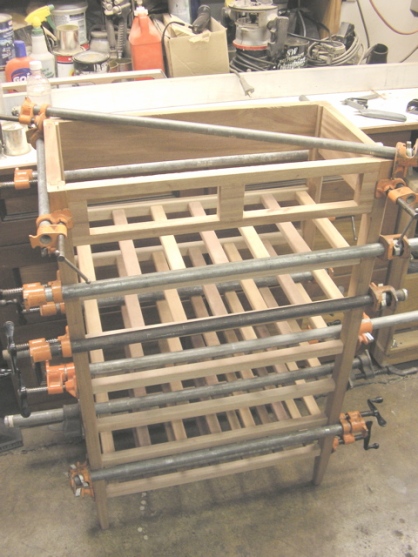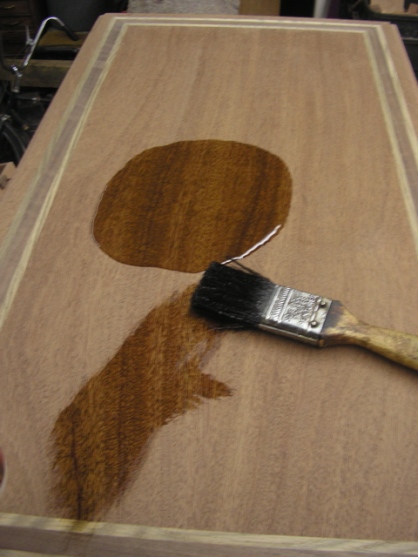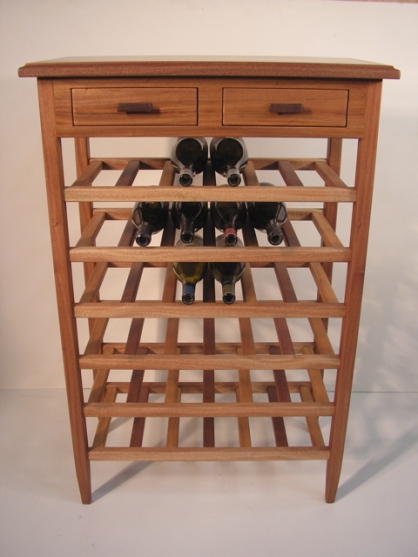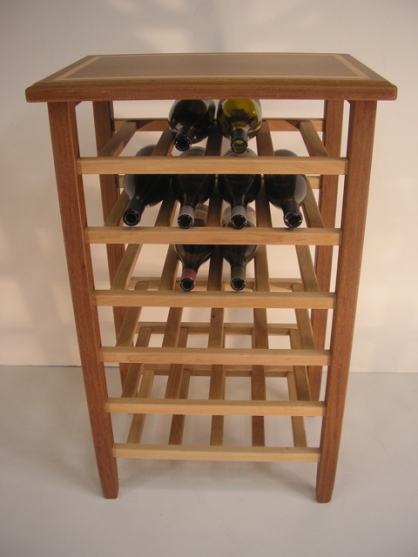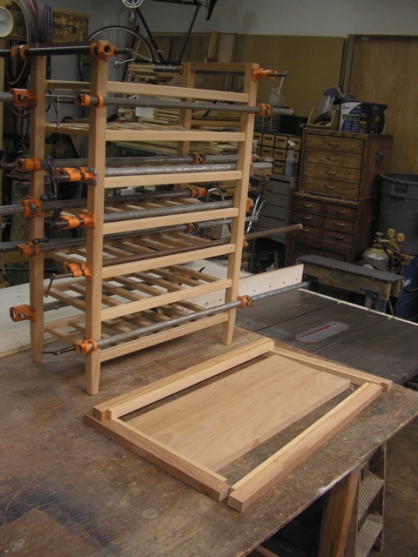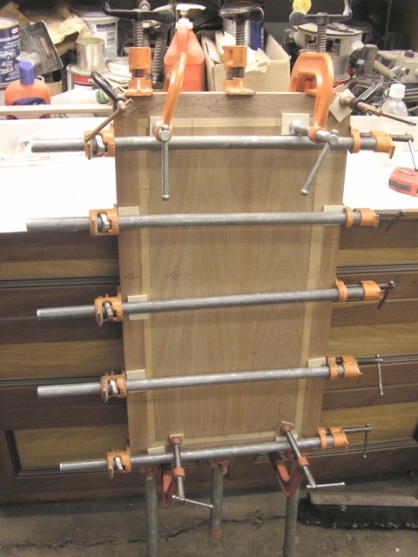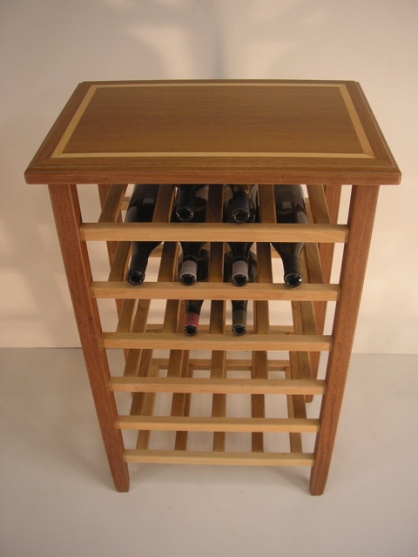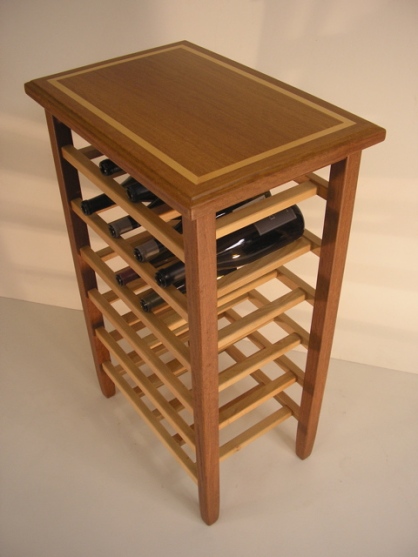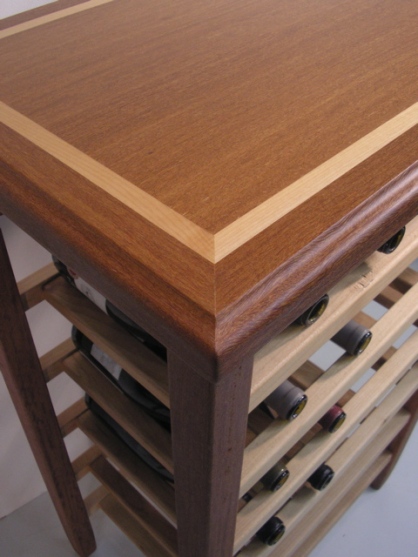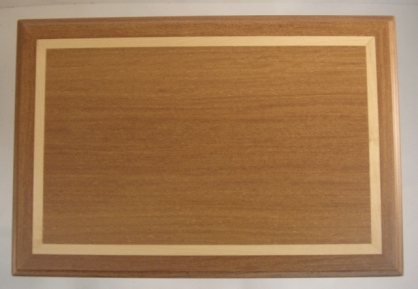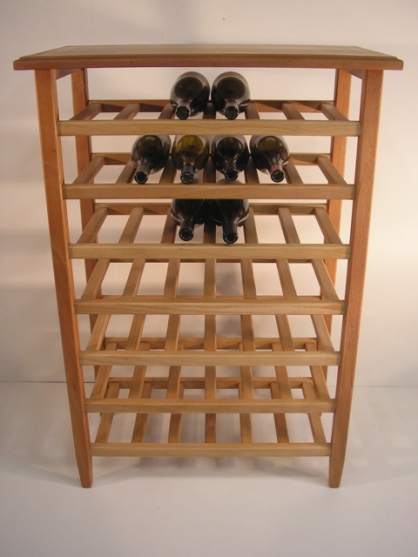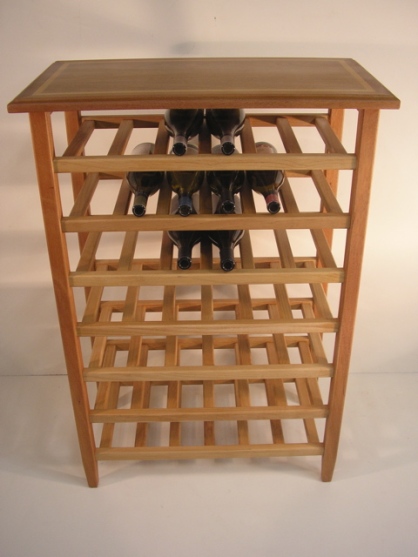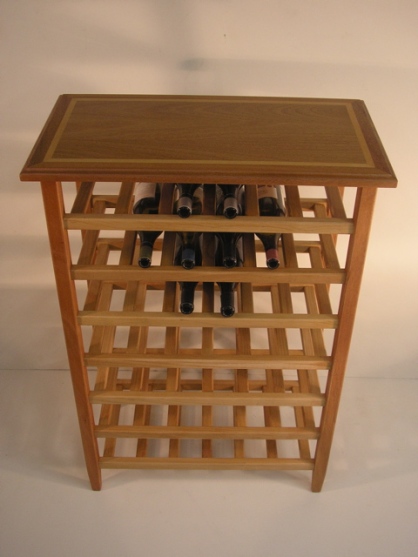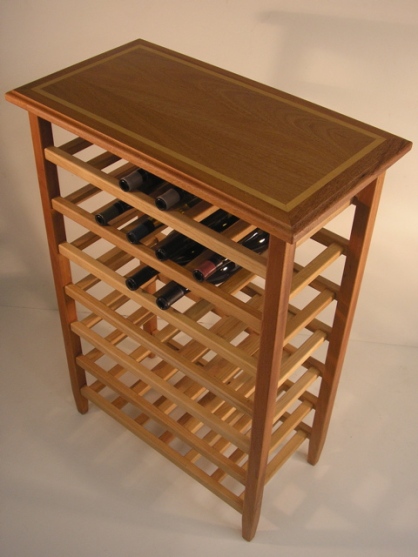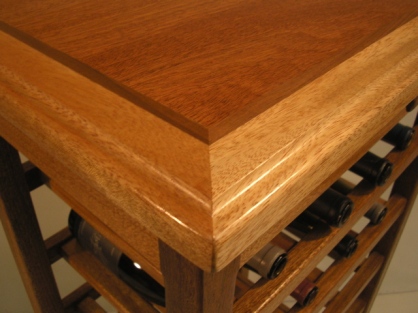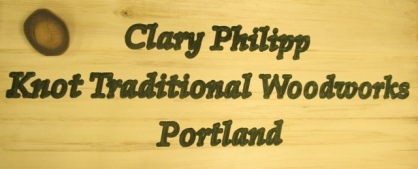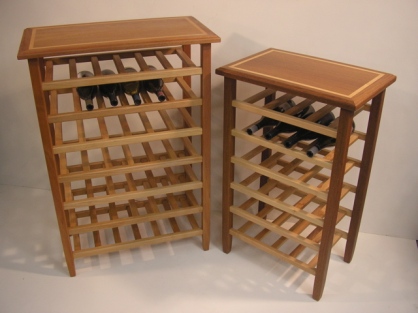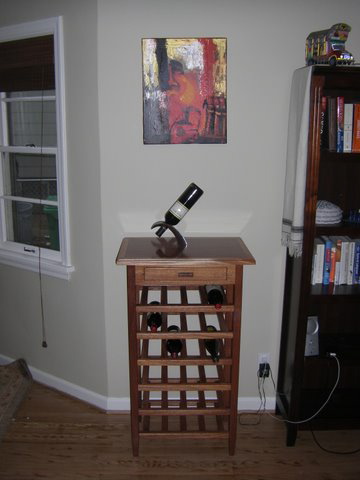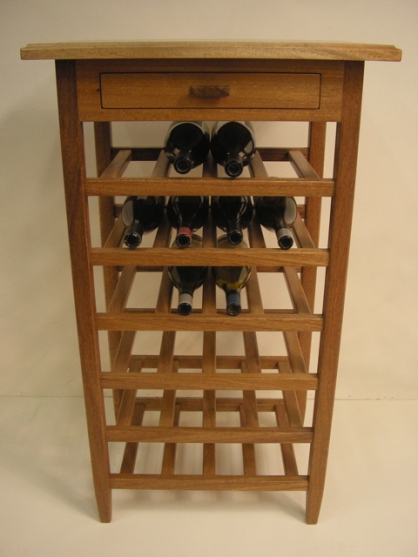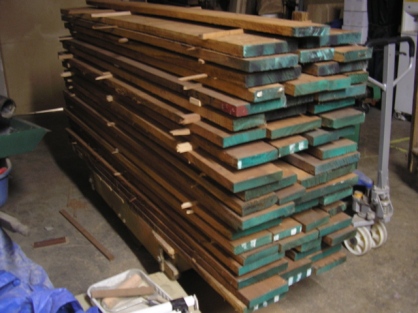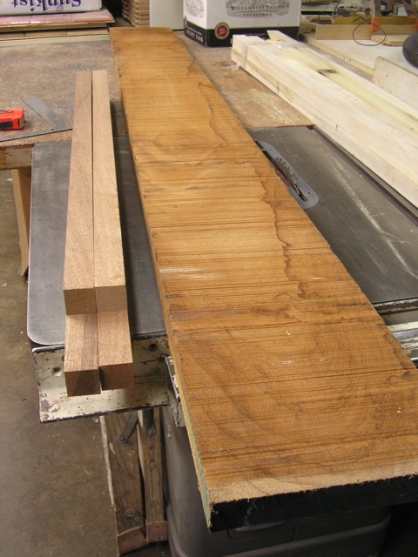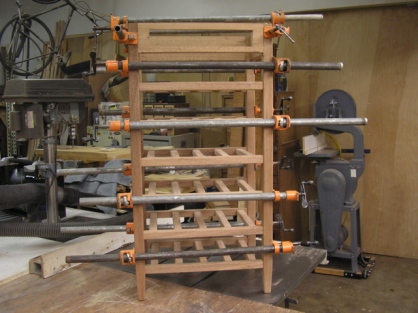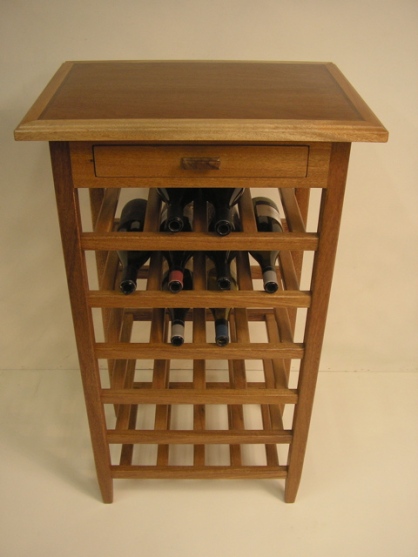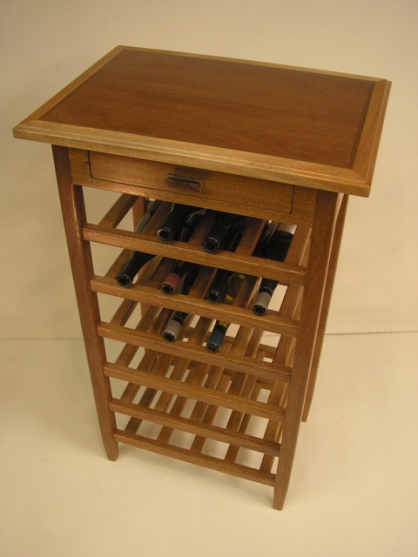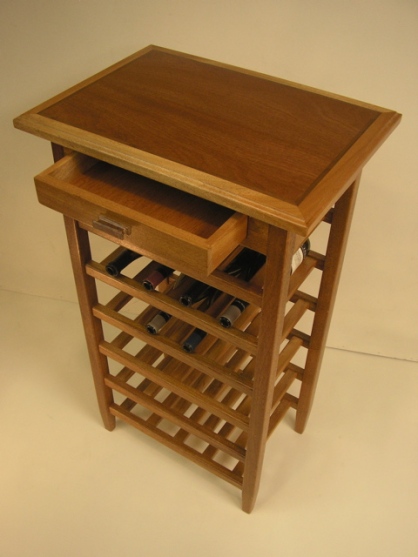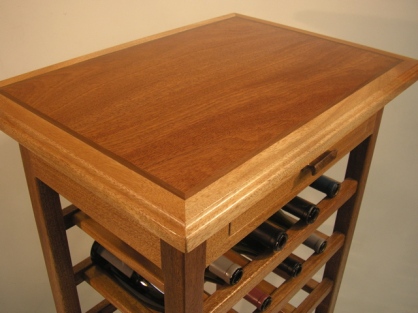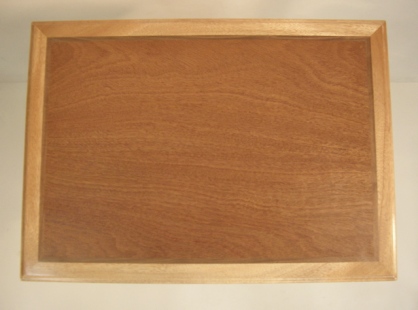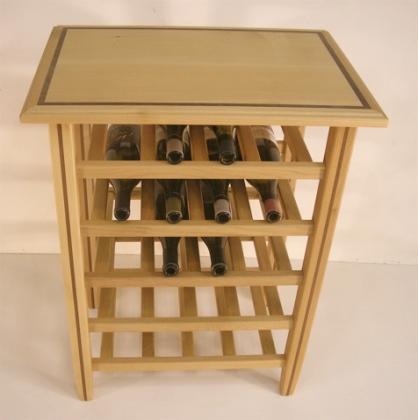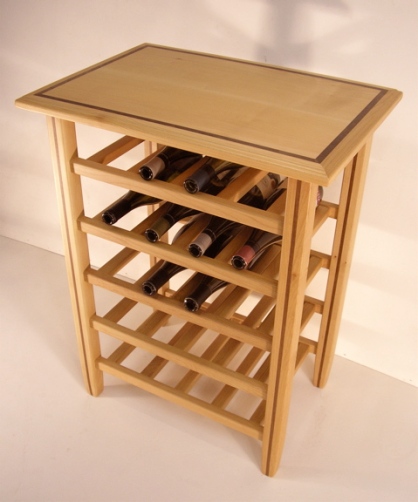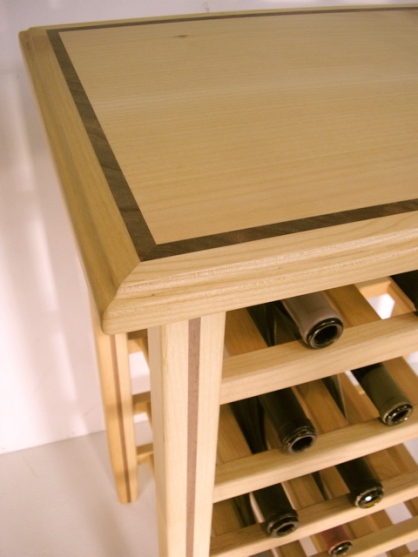Why Wood Wine Racks? Why Knot?
August 9, 2011
Yeah, why would I hand make wood wine racks? It’s not an easy answer… I don’t know… I don’t have a better idea?
I like to work and do stuff with my hands. Woodworking is a cool way to spend time. There are endless opportunities to learn about all kinds of things. A wise man told me that the thing that made it all tick was mystery.
I try to gather up piles of what is other wise wasted scrap material to make something. In this case, I had enough alder to make a taller piece, so I included a drawer and extra cornice molding. I have a few little design motifs that I use somehow on every piece I make. The moulding only works for me on taller pieces and I haven’t included it for a while. The mystery is, what works… what doesn’t? What could I make from this junk?
I do shop drawings and attach cut sheets so I can keep track of parts as I machine material for multiple pieces. Because of the modular nature of my basic design, I can and do change things as pieces get built. It starts with a little voice that asks what would happen if I…??
Some explanation why I make these things could be a kind of fascination with “stuff” and storing your “valuable stuff”. I saw comedian George Carlin way back in the ’60s and he did his famous routine about Stuff. I have always liked jewel boxes, display cases, cabinets that housed collections of stuff.
The real reason is that I read in the paper this week that the Oregon Wine Industry has grown from $500 million five years ago and now contributing $2.6 billion to the economy. The Mystery is how can I get noticed and find a slice of that?
Touring Oregon Wine Country?
August 6, 2011
After visiting all the great wineries and fantastic locations… YOU NEED ONE OF THESE… to hold the liquid gold!!
The summer has finally hit and we are in the 80s. The last couple years we had winter from Thanksgiving until July. Oregonians have coined a term; Junuary, for how dismal the weather was in June. I bet the grapes are loving it now.
Our winters are not that bad really, they just seem to last forever. It gets old, but the summers and fall here are worth it. We get a little bit of snow in the Willamette Valley if we are lucky, but not like the East… that is just crazy. Hey, if we want to see snow, all we have to do look east and Mt. Hood is glistening in the sun. They had great snow pack and were skiing and snow boarding through June. Drive 45 minutes and your in it.
Oh yeah, check out the triple lamination in the top. It’s an idea I stole from my cyber-friend in Austraila, Lazy Larry. The top came out pretty nice. This Mahogany has such a rich color and grain that my poor photography is not doing it justice. The water proof Poly finish I use really make it pop.
To the west is the Oregon Caost. One could be surfing out at Pacific City in the morning and in a few hours be up at Timberline on Mt. Hood looking at the Glacier! If you work it right, you could grab a bottle of wine from a tasting room along the way and cap the day off with a good meal.
My signature drawer pull. I was given four big slabs of this curly Maple from the Seattle area. It is dry as a bone and incredibly beautiful. I’m going to make an electric guitar or bass out of one of the slabs.
A long time ago, Oregonians decided that they wanted to leave the coast free of development, so the beaches and land is mostly like it always was… stunning. As is the rest of Oregon… the Cascade Mountain range through the Central part of the state and the arid high Desert in the east. Big place with not many people.
Portland is a gem of a town. It has taken a ribbing from the Portlandia spoof on YouTube… Portland, the place where twenty-somethings go to retire. A Bay Area musician friend told me… “Portland is like a minature San Francisco only artsier.” Great music and arts scene, and as a people we are into food, beer and wine in a big way.
If you are lucky enough to be touring our Oregon wine country, I think you will find that you have only scratched the surface. You could spend months here… not see it all… and then it starts all over next year and is different.
Check back, I have more to show you soon.
Wine Racks Hand Made In Portland Oregon, USA
August 1, 2011
Are you serious about your stash of wine? GOT RACKS??
A pair of six bottle wide racks that I cut out at the same time. Don’t they look naked without any wine bottles? That is where you aficionados come in…
… fill these racks with wine! Wouldn’t they look better with an eclectic mix of glass colors and labels? Ha,ha, ha!
It would be too easy for me to draw a bunch of different rack designs, then go to my lumber supplier, buy a bunch of material and make them up. The first problem with that is that the material would cost me money. This is not a tool that I have.
If you have followed this blog at all you know that I’m a scrappy, dumpster diving, recycling, reclaiming, up-cycling, woodworking kind of guy. Most of this material was salvaged from my neighbors who build custom uhpolstered furniture. They can’t really use small rips and off cuts from their manufacturing process, so they had been burning them or just putting it into the dumpster.
They buy ASC certified cabinet grade Alder. I really like the different shades of golden brown and tan that the water proof polyurethane finish I use imparts. For the features strip laminations, I use scraps of Oregon Black Walnut from logs I have dried and used for bigger pieces. I can’t bare to toss anything out, and I spend way too much of my time looking through stacks of scraps, to try and visualize what I might be able to make out of them.
I would have made an identicle pair but there weren’t any pieces long enough, so they are as tall as the pieces I could glean for the legs. It is so much harder to design and build pieces from found material.
I try to use the contrasting Black Walnut laminations to be part of the graphic image and design. The real reason is that I don’t get any really thick pieces and the woodworker in me thinks it is better to draw attention to the joinery than try to hide it.
If I had lots of big boards, so that I could make parts with all the color and grain patterns being similar, I could successfully deguise the joints. Still, I sort through stacks of my scraps to find complimentary color and grain patterns. But it’s organic you know? The boards were cut from trees growing out in the mountains. If you want it perfect, make it out of steel or plastic.
The Ultimate Father’s Day Gift!
May 24, 2011
I have to post some more photographs of KTW#6011. Usually by the time I get a piece into the finishing process I’m already thinking about which one of the projects I have sketched and gathered material for to start next. For some reason this piece really makes me smile when I see it. With the stripes in the grain through the drawer carcase, it looks somehow alive.
I’m not so in love with it that I want it. First of all, I can’t afford to own my stuff. Second of all, I have a cool wine rack that I made from White Oak and Black Walnut a few years ago. It is much like this one with the two drawers, but a little smaller, holding 25 bottles. We have only had it full once. Mostly we only have a few bottles on hand, using the shelves to sort the newspaper and magazines. Then they are available to read when we eat, but can have a place to get that stuff off the table. We are Knot very hardcore drinkers.
I spent so much energy, literally blood, sweat and tears building it, that I can’t see getting enough money to part with it. This wine table on the other hand needs to go to a good home. Hopefully to live it’s life in a beautifully furnished kitchen, dining room or even a wine cellar.
My process is being refined with every piece I construct. I’m getting a lot faster and better all the time.
It still takes me an enormous amount of time to make these racks, and there is an element of risk in each step of the process. I just chopped up a table that has been sitting on a shelf for a few years gathering dust. I got 90% into it and made a mistake that I couldn’t recover from. Whoops.
The most difficult thing for me right now is finding nice material and enough material to make at least one individual piece. So far, so good. This Khaya wood looks so elegant. I have enough to make one more like this. I don’t know what I will do with it. I could save it and use it in contrast with other woods.
I think about design all the time. All kinds of design in all kinds of disciplines and media. Woodworking uses a similar kind vocabulary as playing improvised musics, say straight ahead Jazz or Be-Bop. There may be no lyrics, but still there is a kind of universal transference of feeling and emotion through melody, harmony and rhythm.
Working with hardwoods gives that same kind of opportunity for use as a kind of visual vocabulary. There is a kind of visceral transference of energy that happens too, because at one time these objects were alive and growing.
My hands have touched every single surface of this piece many, many times. In the end, I love being able to touch it and have it feel soft and smooth. I want the drawers to have just the right amount of slide and feel to them. I want to look forward to putting my fingers on the drawer pulls, because they feel right.
I could see this in a beach house or ski cabin, with some nice bottles of red parked there for those weekends that make the years memorable.
Your Wine Cellar Needs Another Wine Rack!
May 20, 2011
Here is another floor standing wine rack made from the Khaya (known also as African Mahogany). It’s a 6 X 6, six bottles wide and six racks tall, for three cases worth. The dimensions are 28″ x 15 1/2″ x 42″ tall.
Below: I have glued up contrasting edge band material and crosscut a board, then folded the board back on itself at the cut and glued it up for the field of the top.
There is a woodworking blog that I follow…
http://larrysworkshop.wordpress.com/
Lazy Larry has some very cool ideas about laminating different woods and creating interesting 3D patterns. I decided to start simply and use some of his basic ideas to create my table tops. Above: you see I have ripped some thin strips of White Oak from my dwindling stash that was dried from a fallen tree over on SW Crestwood Lane. I sandwiched a wider strip of Black Walnut, then glued them up with a wide strip of Khaya to form the edge band.
I’m not a very good photographer. I’m of the… take tons of pics… and hope some turn out OK, school of photography. Most of the time. I’m paying attention to what I’m trying to do in the shop, and forget to take shots as I go along in the process of building. Too many times I have stopped to take a photo, been side tracked, only to make mistakes because I forget what I’m doing. I hate that.
Next I milled up the board in the middle here for the legs, rack parts, carcase and drawers…
If I actually took photos of all the individual steps I go through, there would be hundreds of pictures. Unless you are into woodworking, it would be overkill, but I’m just trying to illustrate how many steps there are to making these things… how many steps there are for potential mistakes!
With every new project, I try to refine my ideas and processes, to be faster and still have a shot at quality.
Many woodworkers hate the finishing process. Some do great joinery only to apply bad finishes. I actually like applying finishes and with each piece, I add to my knowledge and experience. Still, it’s like shooting dice and no matter how hard you try there are potential problems. The experts know how to avoid problems and how to fix mistakes and any pitfalls that might occur. Most finishing materials are perishable products and you get one shot at it. Quality finishes are like shooting at a moving target… it’s difficult but not impossible.
Applying a finish is the payoff for me. After I have milled all the parts cleanly and glued everything up square and true, then sanded like crazy… seeing the grain pop out is like opening a present.
Lazy Larry’s lamination idea turned out really cool. I like it. I love the little ripples or “quilting” in the Black Walnut feature strip. There could be so many variations on this concept, I can hardly wait to try some more complex ideas.
More to follow…
Wine Tables, Wine Racks, Made In Oregon!
May 2, 2011
This rack was made from Machiche a very dense, hard, tropical lumber from Central America (sometime called Black cabbage-bark). The racks and feature strips in the mitered edge band on the tops is Alder from Oregon.
The dimensions are 23 1/2″ wide, 15 1/2″ deep and 37″ tall. The field here for the top was assembled from a piece of lumber that was cross-cut in two and folded back on itself. The edge band was cut from the same board so the color would remain consistent.
This Machiche is very hard and seems kind of brittle too, but it also seems dimensionally stable, resistant to expansion and contraction due to changing moisture in the air.
The grain is very beautiful. It’s subtle because at a distance it just seems to have a rich dark color, but up close the grain has a wonderful curly pattern.
The top turned out great. The glue joint is virtually invisible. It’s so cool when things turn out better or different from the way I envisioned them. I think the contrast with the light Alder wood turned out great. I love it when wood seems to have a golden glow to it.
I try as hard as I can to make each piece as well as I can. But still I make small mistakes and I’m working wood with it’s own challenges. No matter how much time or effort I put forth, things are never perfect, so I just do my best, work as quickly as I can, and try to get my kicks making different stuff from what ever material comes my way.
I always expect things to go wrong, because they already have so many times throughout each step of the process. Sometimes, I walk into the shop the morning after applying the final coat of clear finish the night before, and look at my pieces with kind of a detached amazement. Then it all comes back to me… oh yeah that was some idea I had way last month. I looked at some boards and thought I should see what would happen if I did this or that.
It’s great when I can think to myself… that turned out pretty good. So now, #0511 needs a good home and worthy bottles of wine to proudly display!
Wine Racks-Custom Designs-Made In USA
April 29, 2011
Six bottles wide by seven racks high, gives you a 42 bottle capacity. Notice how even the fat Champagne style bottles that many wineries are using for their Pinots fit without touching.
This legs and top of this rack was constructed out of Khaya also known as African Mahogany. The racks and contrasting feature strip laminated into the top are Oregon Alder hardwood.
It is 40″ tall, 28 1/2″ wide and 15 1/2″ deep.
I apply three coats of poly-urethane that is virtually water proof and very stain resistant. I use a satin sheen that brings out the natural color and grain of the lumber, imparts a velvety smooth feel, and gives that hand-rubbed antique effect.
I’m surprised that through the whole stack of boards my neighbor Lavrens passed on to me, each piece has very different shades in the color, but yet has the same grain characteristics.
If you are a serious wine enthusiasts, you probably buy bottles a little too expensive or too many bottles that were a deal that couldn’t be passed up. You could treat yourself to a nice hand made rack like this to stash your treasures!
Custom Wine Racks in Portland Oregon
April 26, 2011
6 x 7 = 42 and 4 x 6 = 24 bottle capacity racks. #4 on the left is Khaya African Mahogany and #5 is Machiche, a very dense hard tropical lumber from Central America (sometime called Black cabbage-bark). The racks and feature strips in the mitered edge band on the tops is Alder from Oregon.
I got a message right after my last posting and so KTW #0311 has found a good home. Thanks for the support Pete… and for sending me photos!
I have some interesting wine rack projects going on and I’m starting to think about slicing up a few logs that have been drying for more than a year in the back corner of the shop . More to come, stay tuned…
Free and Knot Free Wine Racks…
March 26, 2011
Lavrens, my neighbor at the shop, came through for me again. He has a buddy who works or worked for a Canadian lumber wholesaler. A few years ago when the economy was still functioning, they bought units of exotic lumber to sell to high-end users. As the economy was destroyed, they went back to selling construction grade lumber and plywood. That didn’t work either so they closed the warehouse.
When they cleaned out the building, this unit of lumber was not in the inventory, so Lavren’s friend gave it to him, and he gave some to me. It is an African Mahogany called Khaya Ivorensis or commonly Khaya.
I cut one of the pallet skids in quarters for some legs. I was impressed by beauty of the grain and the color. It is fairly hard and dense. I don’t like the way the sawdust smells. It is a little acrid, but not horrible like Ipe, and certainly not as nice as real Honduras Mahogany.
These must have been some big trees because it appears like all heart wood. It mills up straight and true with no warping or cupping. Nice to work with and easy to machine.
Since I had quite a lot of material to choose from, I decided to make a piece that is narrow and a little taller. It holds 24 bottles and has a drawer for cork screws, stoppers and wine glass charms. 23 1/2″ wide x 16 3/4″ deep X 40″ tall.
The top turned out great. I planed a piece, crosscut it, then joined it back on itself for the field. You can barely see the joint.
I used Oregon Black Walnut for the feature strip and drawer pull.
The edge band was from a different piece of lumber. It’s pretty amazing how different the colors turned out from piece to piece. After I sanded everything off, the colors seem rather uniform. The urethane I use made the grain and true colors pop out.
While the grain and figure from piece to piece is very uniform, look how different the legs are compared to the carcase, and the edge band against the field on the top.
Like I said, free from any knots… and my favorite type of wood too… free. Thanks Lavrens!
Knot another wine rack!
February 16, 2011
Yeah, another one. My neighbors who make custom upholstered furniture gave me a bunch of Alder scraps a few months ago. Every month or so, they get a unit of FSC Alder lumber and proceed to make piles of narrow rips and other scraps, perfect for me to mill into rack parts.
I generally try to make parts production style so I can efficiently produce two to four or five racks at a time. This one was cut out along with the rack on my last posting. My deal is to try making all my stuff out of solid wood and not glued up… if I can. It irritates me to look at production furniture and cabinets that boast solid wood, only to see glue joints everywhere.
As I have said before, it would be easy to draw ideas up, go to the lumber yard, buy a bunch of nice material and make cool stuff. The problem is that it costs money. If I could find ways to sell these things and recover that cost, I would be cranking out wild stuff from the many pages I’ve sketched in my design note books.
Sometimes I can find big enough pieces to make solid legs, but in this case, the scraps were wide and long enough, but not thick enough. To solve that, I laminate a different kind of wood so it becomes a part of the design, not just a way to use thinner (cheaper) material, like the typical manufacturing process. In the end, it’s no doubt cheaper, easier, to buy thicker 8/4 material for the legs, but like I said, it cost money. I have way more time than money. I began laminating parts so that they becomes part of the design and look on purpose. In this case, Oregon Black Walnut milled from some logs I dried.
The field for the tops are usually two pieces glued up, either book matched or a single board folded back on itself at the cut, so that the grain matches and many times make the joint invisible. I started using a contrasting feature strip when I laminate the tops for the same reason… make big parts out of small pieces and have the laminations be part of the design.
